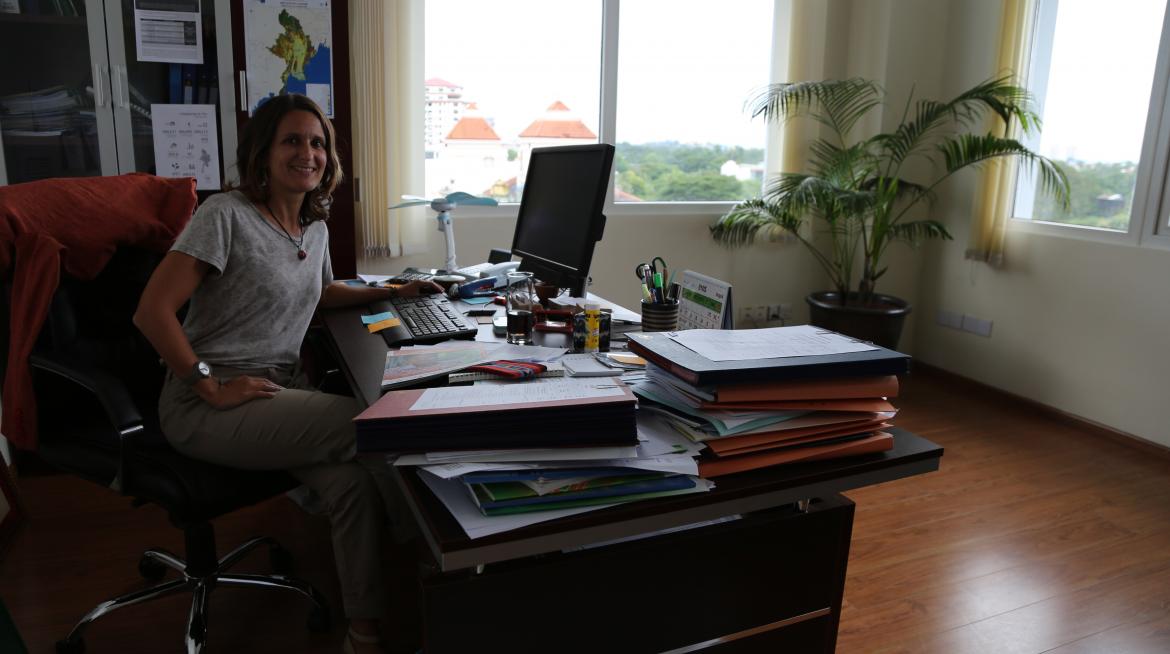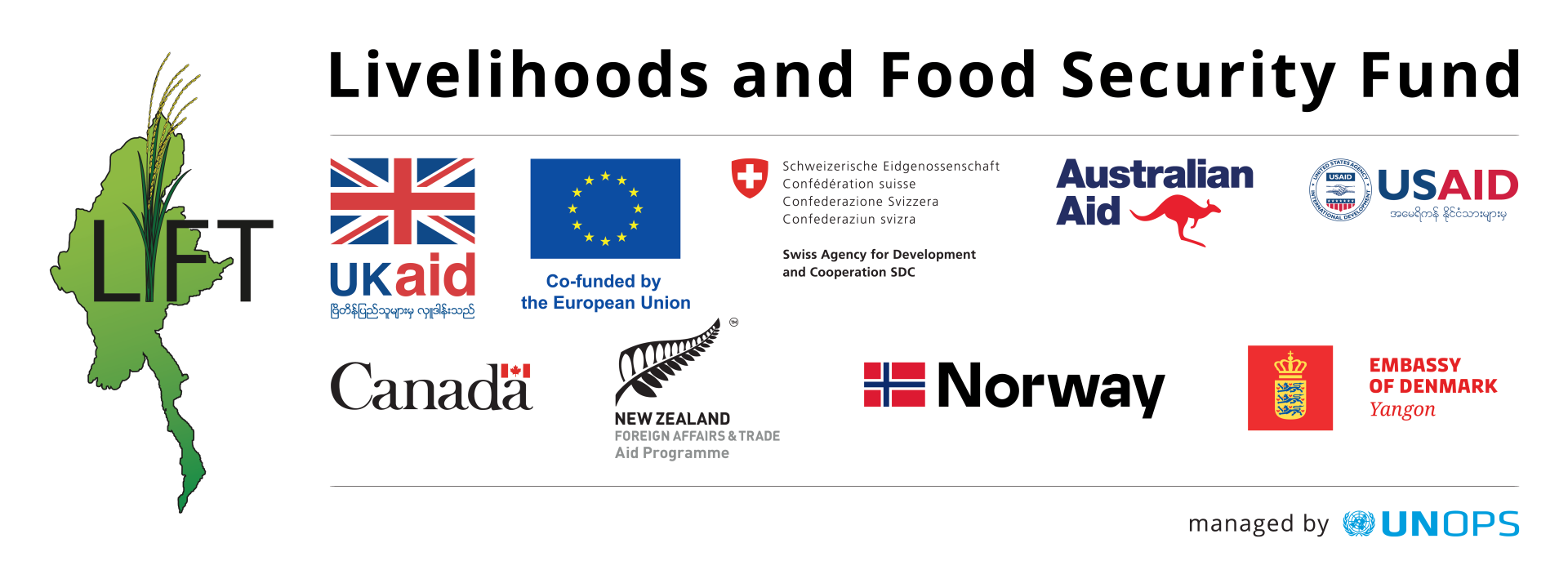
LIFT is a multi-donor trust fund focused on improving the lives and prospects of smallholder farming families and the landless rural poor, funding projects that help them to raise their incomes, improve their nutrition and food security, and their ability to cope with shocks and setbacks. We are generously funded by Australia, Denmark, the European Union, France, Ireland, Italy, Luxembourg, the Netherlands, New Zealand, Sweden, Switzerland, the United Kingdom and the United States of America. From the private sector, the Mitsubishi Corporation is a donor.
For #LIFTDonorProfiles, we’ve interviewed members of our Donor Consortium so that you can learn more about our donors, their development goals in Myanmar and get a better understanding of where LIFT fits in.
We invite you to meet Claudia Antonelli, LIFT Fund Board Chair, from the European Union Delegation to Myanmar.
LIFT: Please tell us a little bit about yourself
I arrived in Myanmar more than two years ago and time has never gone by so fast! It is my first time living in South East Asia and I feel very privileged to be witnessing a democracy in the making, the changes in rural areas and the transformation of Yangon. I have worked in Sub Saharan Africa and Central America previously. It is the first time that I have lived in such a dynamic and forward-looking place. Sadly, in some of the countries where I lived before, time seems to have stopped or political blockage and vested interests were so entrenched that there was no prospect of real change. All the fundamental debates were simply not on the table.
LIFT: Please tell us about the EU's relationship and goals with respect to Myanmar
The European Union's main goal in Myanmar is to accompany the country on its path towards democracy and prosperity. This means working with the government and other key players to build national reconciliation, to support efforts to reduce poverty and inequality, to promote inclusive rural economic growth, decent jobs and an environmentally sustainable growth path.
EU support to Myanmar up to 2020 will focus on education, governance, the peace process and rural development including food security and nutrition.
In rural development the EU is working to:
• improve the climate resilience and the food and nutrition security of rural households,
• sustainably increase wealth in rural areas, with a focus on agriculture
• improve the delivery of basic services to rural communities
LIFT: Where does LIFT fit in?
LIFT is currently EU's biggest programme in rural development in Myanmar. The EU was a founding member of LIFT and played a leading role in setting the Fund up, together with the UK and Australia back in 2008. To date, the EU's contribution to LIFT amounts to EUR 115 million (USD 130 million).
The context has dramatically changed since when LIFT was set up. LIFT started as a fund for livelihood projects in the Delta in the aftermath of Cyclone Nargis. It expanded to other parts of the country, to coastal areas in Rakhine affected by Cyclone Giri and to the Dry Zone. Since then, the numbers of donors has grown to 14, including a private company. And we are hopeful that the LIFT 'family' will continue growing.
LIFT is now a comprehensive programme to promote smallholder-led rural growth, with a focus on farming and off-farming activities including supporting safe migration and promoting good nutrition.
The starting point is to recognise the diversity of rural households. There are farmers with rich and well-irrigated land, close to markets and roads. There are farmers with good land but far from markets. There are farmers who are able to get credit and pay for labourers and renting equipment.There are rural households that have no land, that hope to farm or that hope to leave farming.
Rural households have different potential, needs and aspirations. This is why LIFT's strategy recognises that households have the potential to 'step up' into the value ladder, to 'hang in' the agricultural sector and to 'step out' to other sectors of the economy. Reality is obviously more complex, but this differentiation is helpful in emphasising the need for providing different responses and support to different categories of rural households. LIFT is about creating the conditions for these households to make what they consider to be the best choice.
LIFT: What particular challenges do you see for livelihoods development in Myanmar? How do you think these can be overcome?
In spite of this diversity there are common constraints that come down to a lack of inputs such as quality seeds, water, finance and land or alternative livelihoods.
A common feature of rural households is the need for finance, whether being to improve yields, to start or develop a business, or simply to smooth consumption needs. To respond to these important financing needs is the most pressing challenge. And I am proud that LIFT is working on very innovative programmes to broaden the access to finance and to make financial services more adapted to the needs of rural households.
Promoting better access to water and quality inputs for farmers to get better yields is another major area that LIFT is supporting. There is a huge untapped potential in agriculture productivity not only in rice but also in vegetables, beans and oilseeds. With the right policies and regulations, Myanmar's agricultural future can be grand. All the more if we enable farmers to adapt and deal with climate changing patterns from the onset.
Access to land and improving security of tenure is also a major concern for rural households. LIFT is looking into this issue and among other things is improving our understanding on the practical application of existing laws for example in relation to land access and land titling.
Landlessness is also a major concern. We have to better understand who the landless are, why households do not have land and what livelihood options they would choose if given a choice. Many migrate to the closest town or to other regions. LIFT is trying to improve our understanding on how internal migration works and where relevant support is needed to help people migrate in dignity and in safe conditions. Jobs elsewhere (geographically or sector) are an important part of the picture if we want to understand livelihood strategies.
Finally, better nutrition needs to be targeted specifically. Otherwise, the risk is that increase in productivity and income does not translate into better nutrition status of the population. In Myanmar, 35% of children under the age of five are stunted i.e. too short for their age. These children suffer from lack of adequate nutrition that affects their cognitive development, their learning abilities and ultimately their productive capacity in their lifetime. Beyond ethical considerations, the burden of undernourished population represents a huge cost for the Myanmar economy.
All these constraints do not always affect men and women in the same way. Men and women have different roles and position. We are aware of this difference and take it into account in all our interventions to make sure women are given a voice and space to express their needs and ambitions. It is about empowering women in a rural world that is often male- dominated. We have to think more on the reality of rural lives from a woman's perspective and be mindful of the many weights on their shoulders.
LIFT: What legacy would you like LIFT to have?
I think LIFT is generating very interesting pieces of work that provide valuable insights into agriculture activities and changing trends into the agrarian economy and sociology. These publications are available online.
LIFT can potentially become many things after 2018. I hope it will be able to relay its work to locally owned structures capable of promoting pro-poor and pro-smallholder growth path as well as provide advice on nutrition sensitive policy making. Ultimately it will be about creating the capacity in-country to produce reliable and relevant evidence as well as building the capacity of policy making based on this evidence.
LIFT: How do you see Myanmar in ten year's time?
I see a country where living conditions in rural areas will dramatically improve through better access to finance, better roads, and access to electricity. I see farmers producing more and better, I see more private providers of small equipment and irrigation, and a better connection to the market. I see them getting extension advice from different sources: from the government, from input retailers, from radio, and possibly from digital sources. I see small middle size towns growing as a result of geographically distributed growth and of the growing importance of the rural non-farm economy. I see that stunting will be reduced as part of major effort from the government.
Is it overly hopeful? Probably, but compared to other countries where I have worked you can feel here a sense of ambition, the will to catch-up the lost decades, the will to do it right and to distinguish itself from its neighbours. One of Myanmar's big assets is its social fabric, the sense of solidarity, the pride on their identities. There is an incredibly rich human capital in Myanmar. It is strength, as long as it does not become the fuel for exclusion and the fear for diversity.
LIFT: Is there anything else you’d like to add?
I wish I had more time to learn Burmese! I enjoy listening to Burmese language on the radio. I think it is important to get to speak the language of a country. To me language is what makes one become closer to a culture, to a mind-set and to get to know the country where one lives much better.


